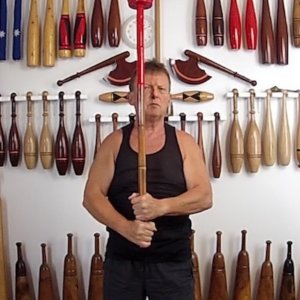Does a Mace need a Pommel?
Pommel or no Pommel? That is the question. NO it does not.
First a Brief History of the Pommel
Historically the name pommel comes from the Anglo-Norman term “pomel” meaning ”little apple” The pommel was originally developed to prevent a sword from slipping out of your hand.
Counterweight
From around the 11th century, they became heavy enough to act as a counterweight for a sword blade.
Grip and balance
The pommel was designed to improve the grip and balance of a sword. This gave the sword a point of balance not too far from the hilt allowing a more controlled and fluid fighting style.
Mordhau Technique
Depending on sword design and swordsmanship style, the pommel was also used as a blunt instrument to strike the opponent using the Mordhau technique.
Mordhau, (German for ”murder-stroke”, “murder-strike” or “murder-blow”), is the technique of holding the sword inverted, with both hands gripping the blade, and hitting the opponent with the pommel or crossguard. This technique allows the swordsman to essentially use the sword as a mace. From Wikipedia
The History of the Mace
The Mace is a close combat blunt weapon that is designed for clubbing, bruising, battery and bashing. It was not designed to cut skin and draw blood with the accuracy of a sword. The Mace is intended to be very clumsy and difficult to handle, featuring a long shaft with a weight on one end and a complete lack of counterbalance.
Weight Difference
- An average sword weighs around 2lbs to 3lbs, and it is easy to mount a counterbalance to control the blade.
- A mace weighs from 15lbs upwards to 50lbs and more so the counterbalance has to come from the athletes own body.
Description of a Gada (Mace) in an Akhara
The Gada (Mace) is approximately 4’6” in length and has a bamboo or wooden handle that is roughly 1” to 1.5” in diameter. The head is carved from stone or made in the Clay Pot method (instructions). There is NO pommel.
No Pommel
Does a Mace need a Pommel? The Traditional Mace from India does not feature a pommel. The Mace is not intended to be pointed and thrust like a sword and does not need a pommel.
Make your own Gada (Mace) in the traditional way
Follow instructions for making a homemade Clay Pot Gada Mace in the ancient and traditional way used in Indian wrestlers akharas (gyms). The process is simple and easy to follow and can be made cheaply by anyone wanting to train with one of the oldest pieces of training equipment around. Best of all there will be NO pommel.
A Common Misconception
Does a Mace need a Pommel? Modern-day Steel Mace manufacturers have opted to place a pommel at the end of their Mace handles stating that the pommel is there for Safety Reasons, namely to stop the Mace from flying out of the athlete’s hands during use.

The Pommel Problem
The downside of the Pommel Mace is that it promotes bad habits by choking the hands against each other and the pommel in a Death Grip or Hammer Grip, especially for unsuspecting beginners. I call this a Choked Death Grip as opposed to a fluid grip which is highly recommended for handling a mace.

Choked Death Grip – Hands Touching |

Skin Grip – Relaxed Fluid Grip |
Knock on Effects of a DEATH GRIP
Does a Mace need a Pommel? The beginners first backswing of a Pommel Mace automatically forces the athlete’s hands together into a Choked Death Grip resting up against the pommel.
Hand on Hand on Pommel
The Choked Death Grip prevents the backswing swooping action of the mace where the athlete should achieve a full triceps extension at the centre back and swing the mace pivoting from the elbows.
Tendonitis
The Choked Death Grip forces the athlete to swing the mace pivoting at their hands high behind the head rather than the nape of the neck and exposes them to elbow tendonitis.
The full range of motion of the shoulder girdle is restricted.
Shoulders Square
The Choked Death Grip also inhibits the correct upper body transverse turns and counterbalance of the mace head during the upward and downward phases of each swing because the athlete tends to keep their shoulders square and facing front.
Leaking Energy
Once the backswing is complete, the mace handle is returned to the front of the body maintaining the Choked Death Grip.
The Grip forces the forearms to be held parallel to the floor and away from the body in preparation for the next swing keeping the forearms and biceps engaged throughout, this, in turn, leaks precious energy and exhausts the athlete’s grip.
Intimate
This is in contrast to keeping the mace handle with no pommel close to the body with a flexible grip and dropping the handle below the navel. Be intimate with the mace.
Circular Swing
The resulting swing is made in a circular fashion and the athlete cannot take advantage of the Push and Pull method which is used when swinging a mace with no pommel creating a heart-shaped swing pattern.
Acceleration
The circular Mace swing has a tendency to accelerate during the 360 style swing which controls the athlete, as opposed to the athlete controlling the Mace.
Rocking Action
Finally, when an athlete swings a mace using the Choked Death Grip they display a rocking action with their hips as if they were doing the Hula Hoop.
Stability
In contrast, when an athlete swings a mace with no pommel, they use a fluid grip, upper body transverse turns, and the Push and Pull method. Their feet are firmly placed on the ground and the hips facing forward, moving their upper body, arms and shoulders to counterbalance the movement of the weight.


Great article concerning maces with a pommel! I own several maces with and without. I am an advocate of feeling different maces and find that they are all really beneficial but after reading your article i find myself thinking! 🙂
Muy buen artículo tengo varias macebell con pomo y después de leer esto voy a fabricar un par de ellas sin pomo para poder experimentar el cambio , muchas gracias
Hi Rubén, Thank you, I’m very happy that you found the article interesting. Let me know how you get on.
Paul really great question with details and insights. There’s a place for both traditional and modern maces to co-exist. But it will depend on 2 factors or points of views. You’re either looking at the pommel from a legal standpoint which is commercial or private. Manufacturers of maces will argue the safety aspect because they’d be liable for an injury. If you’re making your own, then all the risk is entirely on you. Personally, I know almost all commercial maces use a much larger sized pommel, which amplifies what you’ve highlighted…